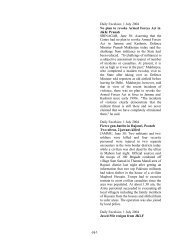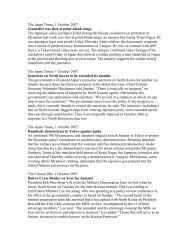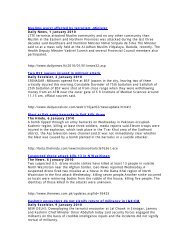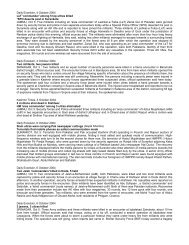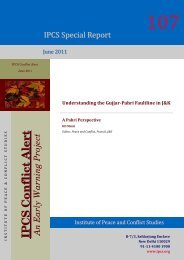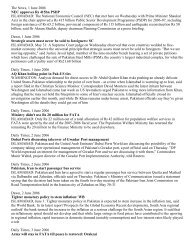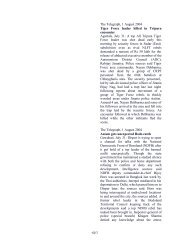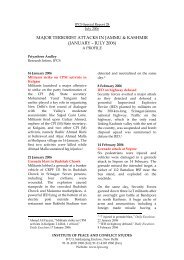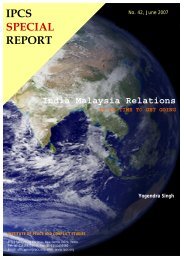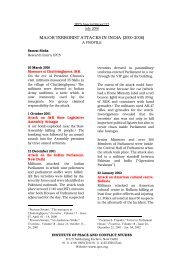April-June 2013 - Institute of Peace and Conflict Studies
April-June 2013 - Institute of Peace and Conflict Studies
April-June 2013 - Institute of Peace and Conflict Studies
Create successful ePaper yourself
Turn your PDF publications into a flip-book with our unique Google optimized e-Paper software.
Commentary<br />
India <strong>and</strong> Pakistan: Political Fallouts <strong>and</strong> Larger Questions <strong>of</strong> the LoC Violations<br />
PR Chari<br />
Visiting Pr<strong>of</strong>essor, IPCS<br />
The ceasefire existing since 2004 along the Line <strong>of</strong> Control<br />
(LoC), which divides Kashmir between India <strong>and</strong> Pakistan, was<br />
recently breached. The consequent firings leading to the<br />
death <strong>of</strong> soldiers from both countries' Armies is tragic <strong>and</strong><br />
needless.<br />
A well-understood mechanism exists to defuse tensions<br />
through flag meetings between local comm<strong>and</strong>ers. Issues<br />
that cannot be settled at a local level are referred to higher<br />
levels for negotiation <strong>and</strong> resolution. The important point to<br />
note therefore, in the context <strong>of</strong> the recent violations, is that<br />
these established mechanisms clearly did not work leading to<br />
tensions at the national level.<br />
Why Do Border Violations Occur?<br />
The LoC is well delineated on the map <strong>and</strong> recognised either<br />
by physical features or boundary markers. A complex medley<br />
<strong>of</strong> factors is generally responsible for these breaches, with<br />
personality issues intervening. A newly posted <strong>of</strong>ficer might,<br />
for instance, wish to impress his senior <strong>of</strong>ficer as having “josh”<br />
(transliterated to mean enthusiasm <strong>and</strong> courage). A superior<br />
<strong>of</strong>ficer might wish to improve his regiment's position for its<br />
easier defence, by plugging an infiltration route or gaining<br />
higher ground. Naturally, the adversary underst<strong>and</strong>s these<br />
tactical manoeuvres <strong>and</strong> wishes to frustrate them; leading to<br />
frayed tempers, heightened instabilities <strong>and</strong>, if not defused,<br />
firings, casualties <strong>and</strong> greater tensions along the LoC. The<br />
Indian Army's st<strong>and</strong>ard explanation that border firings by<br />
Pakistan are intended to facilitate the infiltration <strong>of</strong> its jihadist<br />
elements has become passé, therefore, with the passage <strong>of</strong><br />
time.<br />
Consider the facts <strong>of</strong> the present firings, killings <strong>and</strong> tensions<br />
in the Mendhar sector. The facts are murky, but it seems that a<br />
Pakistani soldier was killed in a small arms firing duel, <strong>and</strong> to<br />
deter the infiltration <strong>of</strong> militants in this area, the Indian Army<br />
constructed a bunker within the no-military-presence zone<br />
along the LoC. Pakistani protests were ignored, leading to the<br />
killing <strong>of</strong> two Indian soldiers on routine patrol duty in bad<br />
weather. What set this border incident apart from several<br />
others in the past was the barbaric beheading <strong>of</strong> one <strong>of</strong> these<br />
soldiers, which has greatly angered the Indian Army <strong>and</strong><br />
people. The Pakistani explanation that jihadis operating in this<br />
area were responsible is questionable, since the LoC is heavily<br />
militarised on both sides. Such an assertion would imply they<br />
were moving around freely in this area, which seems<br />
problematic given the circumstances.<br />
Political Fallouts <strong>of</strong> the Violation<br />
The first political action <strong>of</strong> Pakistan's was to stop the crossborder<br />
movement <strong>of</strong> people, as also cross-border trade<br />
between the two parts <strong>of</strong> Kashmir. For its part, India held up<br />
the agreement negotiated for relaxing visa restrictions, which<br />
included senior citizens being permitted visas on arrival at the<br />
Wagah border, <strong>and</strong> also denied entry to Pakistani singers <strong>and</strong><br />
sportspersons. The linkage <strong>of</strong> border incidents with greater<br />
contacts between the two nations displays the extreme<br />
fecklessness <strong>of</strong> both countries as they are discouraging the<br />
very constituencies that harbour vested interests in<br />
promoting normalcy in India-Pakistan relations.<br />
Fortunately, better sense has now prevailed, <strong>and</strong> New Delhi<br />
<strong>and</strong> Islamabad are taking steps to resume their interrupted<br />
dialogue. With the imminent withdrawal <strong>of</strong> the US <strong>and</strong> ISAF<br />
from Afghanistan in 2014, the need <strong>of</strong> the hour is for greater<br />
coordination between India <strong>and</strong> Pakistan to draw up a<br />
strategy for grappling with the post-2014 situation, rather<br />
than fritter away their energies in internecine strife.<br />
Does, therefore, preventing border incidents, evolving<br />
confidence-building measures (CBMs) <strong>and</strong> deepening Indian-<br />
Pakistani ties require an “uninterrupted <strong>and</strong> uninterruptable”<br />
dialogue between the two antagonists? An ideal solution, no<br />
doubt, but too deterministic to appreciate the political<br />
realities <strong>of</strong> Indo-Pak relations. Dialogue for the sake <strong>of</strong><br />
dialogue, with little hope <strong>of</strong> fruitful results is hardly likely to<br />
commend itself to hard-headed political establishments.<br />
Witness the humdrum manner in which the inter-Korean<br />
dialogue has continued for years after the Korean War ended<br />
in 1954, <strong>and</strong> became a joke. Consequently, faith must be<br />
reposed in the desire <strong>of</strong> the two leaderships to normalise<br />
relations <strong>and</strong> proceed to address their internal challenges.<br />
Is Pakistani Soldiery Under the Control <strong>of</strong> its Military<br />
Leadership?<br />
Let's face it. Despite the growing inability <strong>of</strong> the Pakistani<br />
Army to provide for the country's national security, the<br />
Pakistani civilian leadership only provides the façade behind<br />
which the Pakistan Army actually calls the shots. The country<br />
presently faces four serious threats to internal security -<br />
domestic terrorism that has even targeted the GHQ in<br />
Rawalpindi, as well as naval <strong>and</strong> air bases; continuing losses in<br />
the FATA region to Taliban attacks; American drone attacks<br />
along the Af-Pak border emphasising the country's<br />
abbreviated sovereignty; <strong>and</strong>, secular strife that is tearing the<br />
fabric <strong>of</strong> Pakistan apart.<br />
In this milieu, opening a fifth front just does not make sense. A<br />
plausible reason for the barbaric beheading <strong>of</strong> the Indian<br />
soldier, therefore, could be the extreme frustration that<br />
currently afflicts Pakistani soldiers. Coming from a restricted<br />
recruitment base, family linkages are strong among them <strong>and</strong><br />
discipline has to be strictly enforced from above. Is that<br />
discipline eroding? In other words, is Pakistani soldiery still<br />
under the control <strong>of</strong> the Pakistani military leadership?<br />
South Asia Plus 11



